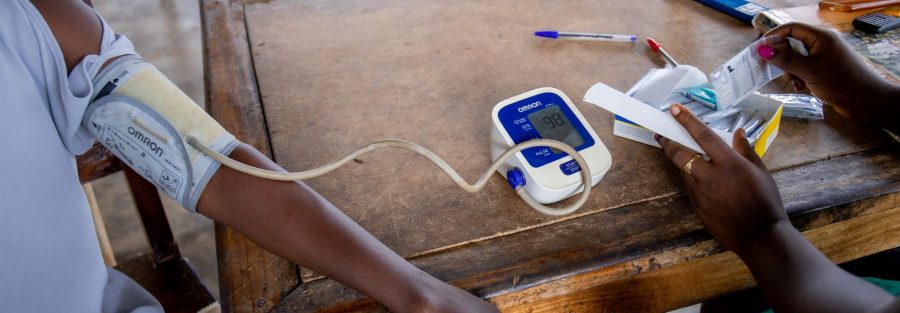It is sometimes the case that individuals who are being assisted to carry a load, forget themselves and in the process leave the burden to the helper. Anyone who has taken time to analyse the health sector’s portion of the national budget at least for the past five years will find this unfortunate situation with the Government of Ghana (GoG). The inadequacy of GoG tax sources to finance the national budget is a well noted challenge, prompting the need for alternative sources. This led to the addition of support lines like Internally Generated Funds (IGF) to the longstanding donor support line and later the introduction of the Annual Budget Funding Amount (ABFA) in 2011 (The ABFA is mainly revenues from the country’s petroleum revenues). These were meant to support existing government tax funding to the different expenditure lines of the health budget. However, what we find currently is the Government spending almost all the tax revenues it allocates to health to wages and salaries leaving little for capital expenditure, goods and services and gradually shifting significant responsibility for capital expenditure to the ABFA and donor support lines. This situation has huge implications for the expectations of ordinary people and communities and their hope for a resilient primary health care system capable of protecting the population wherever they live in the country.
Using ABFA for Health Sector Capital Expenditure in place of tax funding (GoG)
Rightly so, allocations from the ABFA for 2019, 2020 and 2021 to the health sector went solely to capital expenditure. In contrast, in these same years apart from 2021 there were no allocations for capital expenditure from GoG for 2019 and 2020. Even so, the said GoG allocation to capital expenditure in 2021 could have been significant but was only 0.25% of the total allocations from GoG to wages and salaries in that year.
High reliance on ABFA despite low funding to health (ratio of 1:24 to health and education)
Besides the inadequate allocation from GoG to health sector capital expenditure, allocation from the ABFA is also not adequate compared to allocations from the ABFA to similar priorities like education. For some context, about GHC2,768,030,000 was utilised for four ABFA priority areas in 2020. Out of this amount, 25% was reported in the 2021 national budget as spent on Education and Health Service Delivery, about 70% on Roads, Rail, and other Critical Infrastructure (sic), 3% on agriculture and 1% on Industrial Development.
The merger of health and education makes it difficult to unravel at a first look how much specifically went to the two sectors separately; however, it is well known that the Free SHS programme of government utilises a chunk of the funds. For instance, GHS 763,180,024 of ABFA funds was allocated to goods and services for education and GHS 13,000,000 for capital expenditure in 2021 making a total of GHS 776,180,024 from ABFA to education. Meanwhile, the total allocation from ABFA to health in the same year was GHS 32,425,000. This is unfair to the health sector and needs to be corrected as soon as possible given the limited health infrastructure available in districts and communities and current and emerging public health risks.
PIAC Called Out this Anomaly Earlier
PIAC noted about ABFA priorities in an earlier public statement that “Once recognised and selected, priority areas should receive fairly equal amounts of funding. This, however, does not happen to be the case,” They raised issues with the unfair treatment of the health sector in relation to allocations from the ABFA – “For instance, from 2017 to date, Physical Infrastructure and Service Delivery in Health has been the most poorly-resourced priority area as compared to the others. Only 2.61 percent was disbursed to the health priority area in 2017, 2.7 percent in 2018, and 3.65 percent in 2019.”
Implications of Responsibility Shifting and continuous low ABFA allocations to health
Implications of this trend continuing without correction means the universal health coverage ambitions of the Government and people of Ghana will be significantly delayed. Increased and protected funding is needed to provide the facilities and personnel who will work around the clock to ensure the healthcare needs of everyone requiring health services. The Annual Progress Report on the implementation of the Medium-Term National Development Plan in the health sector shows a lot more needs to be done by the government to improve the health security of residents of Ghana. The number of functional Community-based Health Planning and Services (CHPS) zones expected in 2019 missed the national target by about 468 CHPS compounds. Doctor-to-population ratio remains a challenge in the country despite improving from 1:7,196 in 2018 to 1:6,897 in 2019. Compared to the WHO standard of 1:1320, it is one of the troubling issues that needs to be addressed.
Persistence of the financial non-commitment means the ideal health targets necessary for UHC will keep eluding the country.
Policy pronouncements need to match practice
The commitment of successive governments to make health care services available to all residents of Ghana is not in doubt. However, governments have said all the correct words and signed the many international conventions that have been presented, but we see very slow movement on the most important commitment lever i.e., we are yet to see fundamental moves on the money side of the equation. For many poor and vulnerable people, the financial commitment cannot come soon enough because weak or unavailable primary health facilities are a question of life and death for many. All they have now are their votes which they cast every four years to choose the leader that responds to their basic needs. President Kufour’s NHIS, President Mills One Time NHIS Premium Payment (bait and switch) and President Nana Addo’s Free SHS policies teaches that anytime a party elevates and prioritises the most basic needs of society, they gain the votes of ordinary people.
As shown above, the current ratio of 1:24 in the distribution of ABFA allocations between health and education could be corrected.
Any social policy that ensures equity like the FSHS or accessible quality Primary Health Care are worth supporting, as such, there is no need to quibble over what is rightly allocated to FSHS but rather a call for similar investments to improve district and communities’ health facilities and services (primary health care) is in order. If it is impossible to increase the ABFA share to health due to a potential adverse effect on the FSHS policy, then the government should consider ring-fencing the COVID-19 Health Levy for goods and services and capital expenditure in the health sector.



